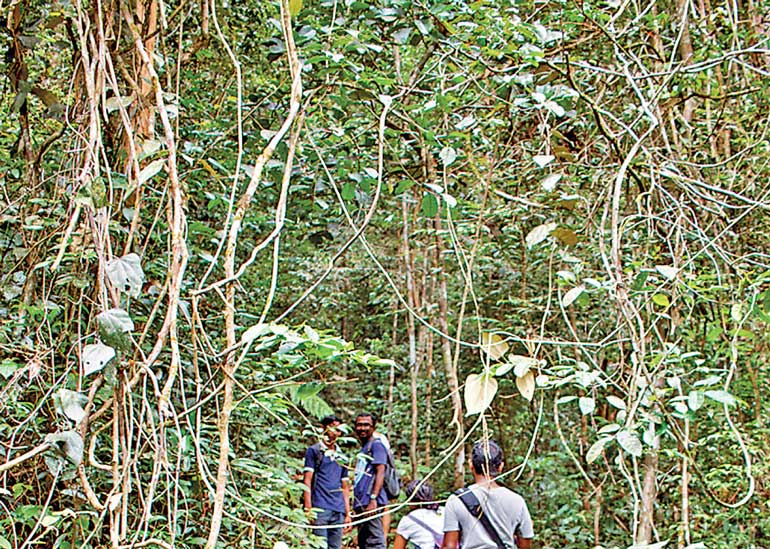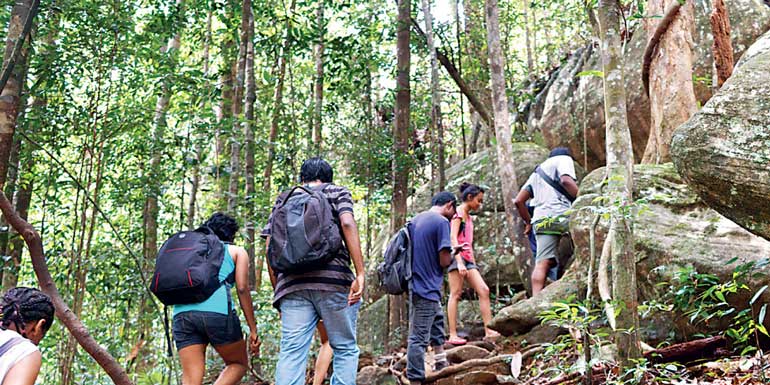Thursday Nov 27, 2025
Thursday Nov 27, 2025
Saturday, 22 August 2015 00:00 - - {{hitsCtrl.values.hits}}





By Himal Kotelawala
When yours truly and a few close friends decided to go trekking in the Sinharaja Rainforest on a whim last Saturday, we had every expectation that it was going to be a disaster. Even though there were several experienced trekkers among us, the sheer spontaneity of it and the fact that none of us had set foot on the reserve before did not bode well for the trip.
With little to no preparation barring some Siddhalepa and soap to fend off leeches, we set off, four guys and five girls, at six in the morning, hoping for the best. Little did we know that our fears were largely unfounded and that we were actually in for a treat.
Our ragtag band of adventure-travellers usually prefer to take public transport on our excursions, but this time, we opted to take two cars – a decision that really paid off in the end; but if you would rather bus it, by all means do so. The picturesque terrain on either side of the road will make it worth the effort. It’s about the journey, after all, not the destination, as the cliché goes.
There are several ways to get to Sinharaja. There is the Kudawa entrance via Kalawana, the Pitadeniya entrance via Deniyaya, Matara, and the so-called Morning Side entrance also via Deniyaya. Kalawana being the closest to Colombo, we decided to take the Southern Expressway there, with a little help from Google. The plan was to somehow end up at the Kudawa Conservation Centre (KCC), the entry point to the forest reserve, by at least 10 a.m.
The easiest way to get there is to take the Dodangoda exit from the expressway, head to Kalawana via Mathugama and make your way to Weddagama/Pothupitiya at the end of which you’ll find the KCC, which is about 65km from the Dodangoda exit. That’s roughly 160km from Colombo. The route is as scenic as it gets, and it’s tempting to stop halfway and just take in the view down the valley. The car that I was on got lost somewhere near Pothupitiya and, as there were no phone signals and therefore no Google Maps, we spent a fair bit of time doing exactly that, much to the chagrin of the others.
We reached the KCC around 10.30, and spent another good 20 minutes getting tickets (Rs. 100 each) and applying Siddhalepa on every inch of exposed skin. (The more adventurous among us had, inexplicably, decided to go trekking in a tropical, leech-infested rainforest in shorts. Not recommended).
We were assigned a guide, Ranjith, a friendly, energetic and sufficiently enthusiastic young man who seemed to know what he was doing. Guides assigned to travellers by the KCC are usually knowledgeable and experienced trekkers, but you have to ask them questions to really get them talking. Fortunately for us, Ranjith turned out be a walking encyclopaedia on the flora and fauna of the country’s only existing rainforest and was very forthcoming with his expertise.
Thus began the trek proper. The trail we picked was one of the shorter, less strenuous ones, taking into account how some of our number were novices. Halfway into the trail, however, Ranjith offered us a choice: to either stick to our 2.5km trail, or locate and climb Sinhagala, or ‘Lion Rock,’ a mountain peak hidden deep inside the forest whose view from the top was said to be nothing short of spectacular.
Ranjith did a commendable job of selling the latter option, getting everyone psyched for the climb to the top by informing us that we would be able to see all the way out to Galle and Matara from the summit. He had pictures on his phone as proof, and that was all the convincing we needed, and off we went.
August is probably not the best time of year for this particular trail that we were on, but it’s not too bad. While scattered showers are fairly common (we hadn’t packed any raincoats, unprepared as we were), it is not what you would call torrential and some sunlight does seep through the canopy above. It was a bit humid at the start of the trek, however, and the skies were becoming increasingly overcast and foreboding as the day went on. But we were determined to keep going.
This trail also is also great for spotting bird and insect species endemic to the UNESCO World Heritage Site. We ran into a surprisingly friendly jungle fowl on our way up the mountain and encountered various types of bugs and worms with names that were too long and complicated for this writer’s feeble memory. We were also lucky enough to [barely] spot a purple-faced langur, a type of monkey endemic to the reserve hidden in the thicket. The higher up you go, the animals get smaller in both size and number, as the trees grow thicker and vines creep closer in on you.
If you’re travelling in a group, be sure to carry at least one bottle of water per person. We had run out of water less than halfway into the trek when we came across the only stream on the way to the top, where we stopped for a short break and gratefully filled the two water bottles we were carrying. (Did I mention that we were unprepared?) While you’re not going to die of thirst in the middle of a rainforest, dehydration can be a real drag; so take as much water with you as possible.
The trail was now getting steeper and steeper, and our stops were becoming more frequent. It was midday already and the rock wasn’t even within sight yet; and we had no food in our stomachs apart from some paang and parippu we had had at a roadside tea shop near Mathugama. But we had to keep going. Ranjith was getting impatient.
It must’ve taken us about another hour to reach the rocky terrain of Sinhagala. It wasn’t very big. No more than 50 feet to the summit, from the top of the earthy, forest covered hill we had been climbing. A few of us dashed to the top. Nothing could’ve prepared for the magnificence of the view that awaited us. To say it was breath-taking would be an understatement. Ranjith could only look at us in glee, as we were gazing the horizon, in utter awe at the majesty of the canopy that lay beneath us and the distant misty mountains that seemed to form a ring around the reserve. Trees of varying degrees of height and thickness for miles around us, with their lush greenery as far as the eye could see. It was fantastic. Made the long, challenging hike with little water and no sustenance totally worth it.
We spent a good deal of time on top of Sinhagala, just taking in the view (and taking a ton of pictures). On a less gloomy day, we might’ve been able to spot Galle in the distance, Ranjith pointed out. But no matter. It was a sight to behold, regardless. If you are ever faced with the option of taking the easy trail or climbing Sinhagala, do pick the latter. You won’t regret it.
It was time to go back down. You might think descending is easier than climbing, but it’s really not. The impact on your knees is greater, so take care not to land too hard on your feet when you jump your way down the mountain, tempting though it may be. We were slowed down considerably by an unexpected downpour on the way back. We were all pretty drenched by the time we made it to level ground, but it was part of the fun. What’s a rainforest without a little rain?
It was around 4 o’clock when we made our back to the KCC. We spent some time getting rid of leftover leeches – and there were quite a few of them, mind you. (We recommend soap. It’s a pretty effective and safe leech-repellent). The KCC is equipped with running water and a changing-area/shower where you can get out of your drenched clothes. Do check yourself thoroughly for any leftover leeches. We cannot stress this enough. Those things can get pretty nasty if you let them linger for too long.
With all that done, it was time to go. We thanked Ranjith for his tremendous help and what was genuinely a great time, and set off in search of food, for we were ravenous!
Pix by Malinthe Samarakoon